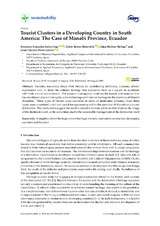Mostrar el registro sencillo del ítem
Tourist Clusters in a Developing Country in South America: The Case of Manabì Province, Ecuador
| dc.contributor.author | González Santa Cruz, Francisco | |
| dc.contributor.author | Torres-Matovelle, Pablo | |
| dc.contributor.author | Molina-Molina, Gina | |
| dc.contributor.author | Pérez-Gálvez, Jesús C. | |
| dc.date.accessioned | 2019-09-02T11:36:08Z | |
| dc.date.available | 2019-09-02T11:36:08Z | |
| dc.date.issued | 2019 | |
| dc.identifier.uri | http://hdl.handle.net/10396/18948 | |
| dc.description.abstract | Societies nowadays shape their history by establishing traditions, customs, artisan expressions and, in short, the cultural heritage that represents them as a people in symbiosis with their natural environment. The present investigation analyzes the tourist phenomenon that has developed around intangible cultural heritage and natural heritage in the province of Manabí (Ecuador). Three types of visitors were identified in terms of motivation schemes; these three types were considered valid and useful for segmenting within the province of Manabí as a tourist destination. The conclusions suggest the need to conceive tourism products that improve the image of the destination and, at the same time, enable the sustainable management of the destination itself. | es_ES |
| dc.format.mimetype | application/pdf | es_ES |
| dc.language.iso | eng | es_ES |
| dc.publisher | MDPI | es_ES |
| dc.rights | https://creativecommons.org/licenses/by/4.0/ | es_ES |
| dc.source | Sustainability 11(16), 4329 (2019) | es_ES |
| dc.subject | Intangible cultural heritage | es_ES |
| dc.subject | Natural heritage | es_ES |
| dc.subject | Tourism | es_ES |
| dc.subject | Motivation | es_ES |
| dc.subject | Satisfaction | es_ES |
| dc.subject | Developing countries | es_ES |
| dc.subject | Ecuador | es_ES |
| dc.title | Tourist Clusters in a Developing Country in South America: The Case of Manabì Province, Ecuador | es_ES |
| dc.type | info:eu-repo/semantics/article | es_ES |
| dc.relation.publisherversion | http://dx.doi.org/10.3390/su11164329 | es_ES |
| dc.rights.accessRights | info:eu-repo/semantics/openAccess | es_ES |

